Neither Aaron Sanchez nor Marcus Stroman relies upon a four seam fastball as their primary hard-type offering. This has led many to envelop the hard-type pitches that they do throw into one single category with an interchangeable name; sinkers and two seam fastballs. While it’s an understandable association to make, given that both have great movement and generate a deluge of ground balls in the direction of the Blue Jays gold-glove infield, the journey that the pitches take from the release point to the catcher’s mitt have about as much in common as the stature of the men throwing them. Unless you’re Buck Martinez you wouldn’t call a cutter and a slider the same pitch, so you shouldn’t do that for fastballs with movement, either.
I’ve talked a lot about spin angles before, and how they are one of the primary driving forces behind the characteristics of movement on a given pitch. Thinking big picture for a moment, there are two hemispheres of rotation: topspin and backspin. Topspin, a phenomenon which happens when the Magnus Force acting on the ball pushes it downwards, occurs when a pitch is thrown with a spin angle between 270 and 360 degrees, or between 0 and 90 degrees. For right handed pitchers this 270 to 360 degree range is a dead zone outside of theoretical endeavors, as it’s where a “left handed curveball from a right handed arm slot” would be found. While it’s physiologically possible, throwing this type of pitch is not recommended due to the strain associated with the exaggerated pronation required. The 0 to 90 degrees window is where most curveballs and sliders are found, as the only two pitch types that have more vertical movement than a spinless baseball.
Some sliders cross the hemisphere into backspin; creeping towards the 135 degree territory of cutters. These sliders are more of the Frisbee variety, lacking the two-plane depth and bite of their top spinning counterparts. At 180 degrees is the realm of four seam fastballs, whose movement falls almost entirely within the vertical plane. This is where the myth of the “rising” fastball took hold. The backspin can become so encompassing that the pitch hardly wavers on its course to home plate, refusing to sink and arriving upwards of thirteen inches higher than a spinless pitch of equal velocity would have.
The 180 to 270 degree field is where the distinction between sinkers and two seam fastballs occurs. As I stated, 180 degrees represents total backspin, but the 270 degree spin angle represents an equal point of purity of its own. When thrown by a right hander, a ball with a spin angle of 270 degrees will sink vertically at the exact same rate as a spinless pitch (i.e. a vertical movement of zero inches), while running towards the arm side as a mirror to a perfectly cut fastball. Marcus Stroman’s sinker is trending in the direction of this perfect apex. Aaron Sanchez’s two seam fastball is not.
On Figure 1 above, the average spin angle and vertical movement values have been plotted for all sinkers thrown by right handed starters in 2015 (minimum 100 thrown), with the pitch classifications determined by Baseball Prospectus and Brooks Baseball (neither has a “two seam fastball” variation). When removing side-arming Justin Masterson from the population we have a sample of 124 pitches. Among them, Marcus Stroman’s sinker had the fourth highest average spin angle at 262.18 degrees, and the second most average vertical movement with just +2.09 inches relative to a spinless pitch. Only Ryan Weber, Tim Hudson, and Charlie Morton had an average spin angle closer to 270 degrees, and only Morton generated more sink. Aaron Sanchez, conversely, had a spin angle of 244.67 degrees (31st highest), and +5.68 inches of vertical movement (46th). Given what we know about the physical forces acting on the ball, it’s unsurprising to see a strong correlation coefficient of 87.5 percent between spin angle and vertical movement. Stroman’s sinker is at one extreme, whereas Sanchez’s two seam fastball is located more within the central cluster.
Among the sample of 124 pitches, the spin angles range from 199 to 266 degrees, and the vertical movement spectrum spans over eight-and-a-half inches of sink – this is more than one pitch type.
The reason that many choose to combine the two pitch types into one header is that despite taking differing paths to arrive at the same destination, both are more than capable of inducing ground balls as Figure 2 below shows. The correlation between spin angle and groundball rate is a modest 18.0 percent, but the dataset has a positive trend and the 124 pitch sample as a whole has an average groundball rate of 53.6 percent.
The Marcus Stroman sinker can once again be found at the absolute extreme, as his 76 percent groundball rate was the best among the group of right handed starters. With a 63 percent mark of his own, Aaron Sanchez ranks an impressive seventeenth as he too is pulling away from the central group by this measure. Even so, there is a considerable gap between the two, and an even bigger gap between the two Blue Jays and the rest of the sample of pitches. The spectrum of spin angles is wide, and while the spin angles correlate to vertical movement, the direct correlation to groundball rate is fairly weak.
You should never classify pitch types based upon their average plate appearance result, but I decided to search for a stronger correlation than the 18 percent between spin angle and groundball rate as another way of helping separate the pack based on what happens between pitch release and plate arrival. In doing so I calculated three new movement variables – net vertical movement, vertical aspect percentage, and hypotenuse movement. Net vertical movement is important due to the way in which movement is expressed – relative to a spinless pitch. When people read that one pitch has a vertical movement of 2 inches and another has 10, they assume that the 10 is better because it’s a larger number and they aren’t aware of the reference point being used. For this calculation, I instead set the reference point to one approximating a four seam fastball – more specifically, Mat Latos’ two seam fastball and its entirely unimpressive vertical movement of +10.63 inches (the worst mark in the 124 pitch sample). Therefore, Mat Latos’ net vertical movement is 10.63 – 10.63 = 0.00 inches, whereas Marcus Stroman’s is 10.63 – 2.09 = 8.54 inches. This isn’t necessarily fair to Mat Latos, but nobody is here to read about Mat Latos’ two seam fastball so we can continue accordingly.
The vertical aspect calculation was a simple division of the net vertical movement by the sum of the horizontal and net vertical movement, to give a percentage expression of how much of the total movement of the pitch is in the downward direction. For Stroman, this value was a league best 55.3 percent (8.54/6.91 + 8.54). In fact, Stroman is lapping the field in a sense as the gap between him and the second place Tim Hudson (50.5 percent) is roughly the same as the gap between Hudson and the eleventh ranked Zachary Godley (45.3 percent). Stroman and Hudson were the only two pitchers who had a better-than-equal vertical aspect. With 9.57 inches of horizontal run and just 4.95 inches of net vertical movement, Aaron Sanchez’s 34.1 percent vertical aspect ranks 71st. Quite the difference. As Figure 3 above shows, there is once again a positive correlation between the vertical aspect and groundball rate percentages, with the coefficient being a respectable 25.1 percent. We might need to rename his pitch “Wilson”, because at least statistically, Marcus Stroman’s sinker lives on an island.
Next, the hypotenuse movement was calculated by finding the square root of the sum of the squares of the two directions of movement – horizontal and net vertical. Sinkers/two seam fastballs move down and to the arm side, so the hypotenuse movement value would reflect the total distance moved along that hypothetical plane. According to hypotenuse movement, Stroman and Sanchez are neck in neck with 10.99 and 10.77 inches, ranking 14th and 18th out of 124, respectively. Hypotenuse movement and groundball rate have a correlation value of 16.7 percent; this intermediary point is clearly not what we’re looking for. What we can do with the hypotenuse, however, is determine the angle of movement, which is different than the spin angle of the pitch and beautifully displays the contrasting styles of Stroman and Sanchez despite their near identical total distance of movement.
The perspective of the above triangle is that of the pitcher facing towards the plate, with his release point being the uppermost point of the triangle. The angle of movement can be calculated by taking the inverse-sine (or arcsine) of the horizontal movement divided by the hypotenuse movement. The larger the angle, the greater emphasis the pitcher has on generating horizontal movement.
Unsurprisingly, Marcus Stroman has the most acute angle of movement at 38.98 degrees due to the floor dropping out of his sinking fastball. Aaron Sanchez’s two seam, running fastball has a more obtuse and middle of the pack angle of movement of 62.65 degrees. Mat Latos’ angle of movement appears as 90.00 degrees, which obviously isn’t reflective of reality; it’s merely a side effect of using his pitch as the baseline of movement for others. Because angle of movement is basically a different representation of the vertical aspect percentage we saw in Figure 3, the coefficient of correlation is a nearly identical 25.2 percent.
If you take away one thing from these four figures, I hope it’s that while the end result of both tends to be very positive, the trajectories of Marcus Stroman’s sinker and Aaron Sanchez’s two seam fastball don’t have a whole lot in common. The name given to the group of pitches does a disservice to those found at the true extremes who are so clearly attempting to do something different and unique. A whopping 66.9 percent of Aaron Sanchez’s pitch movement is in the horizontal direction, yet we’ll call it a sinker because it results in a lot of groundballs; running fastball seems like a more fitting name for the offering. The term sinker should be reserved for the likes of Marcus Stroman and Tim Hudson and Lance Lynn, who are out on the mound doing everything they can with their grip, their arm action, and their release to maximize the vertical movement generated. Trends in outcomes should be evaluated after the pitch type classification has been made, it shouldn’t be the determining factor of the classification itself.
Lead Photo: Kim Klement-USA TODAY Sports

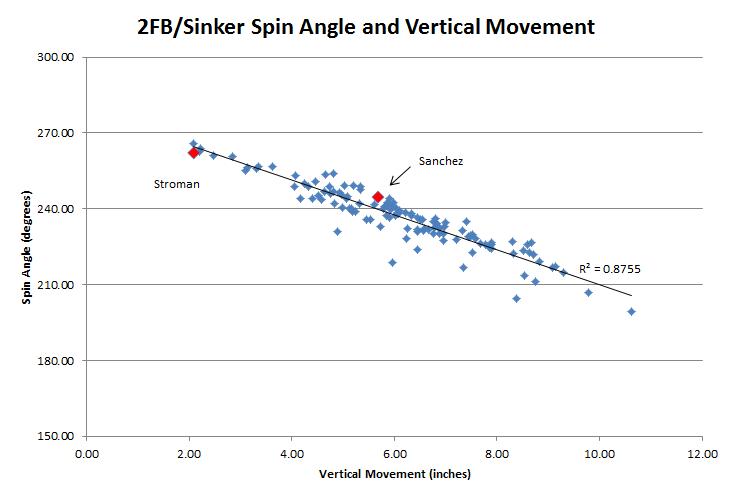
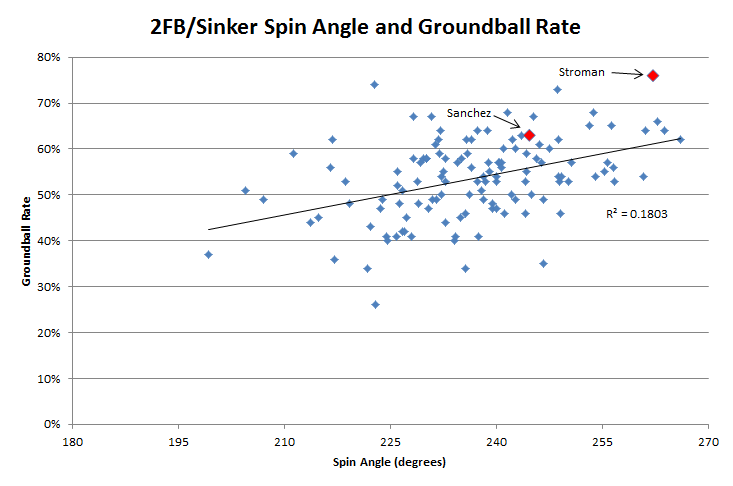
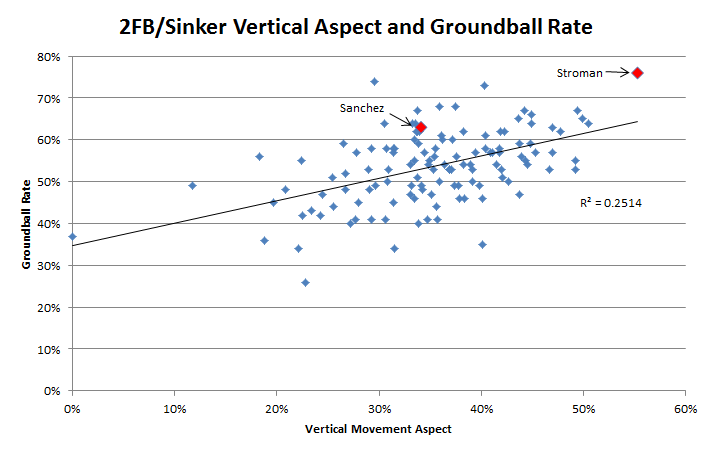
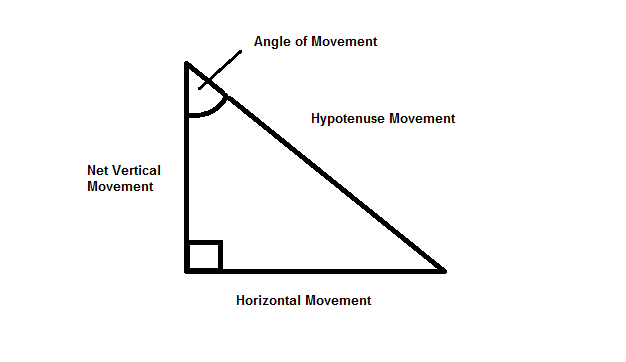
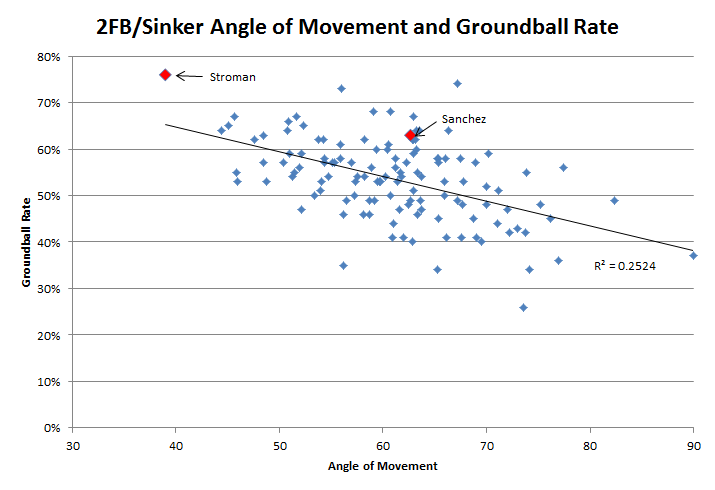
(8.54/6.91 + 8.54) =/= (8.54/(6.91 + 8.54))
The momentary confusion caused by this equation not withstanding this was a truly excellent article with a very clear exposition. I appreciate the clarity with which you spelled out your process and the conclusion you found is highly compelling.
I know the order of operations, I just really didn’t like the way it looked in written form and trusted y’all would figure it out. Glad you enjoyed the rest of it though!